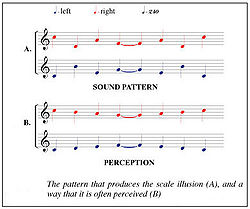
Deutsch's scale illusion
Encyclopedia

Diana Deutsch
Diana Deutsch is a British-American perceptual and cognitive psychologist, born in London, England. She is currently Professor of Psychology at the University of California, San Diego, and is one of the most prominent researchers on the psychology of music...
in 1973, Deutsch's "scale illusion" is an auditory illusion
Auditory illusion
An auditory illusion is an illusion of hearing, the aural equivalent of an optical illusion: the listener hears either sounds which are not present in the stimulus, or "impossible" sounds...
in which principles of grouping
Grouping
Grouping is a form of hierarchical knowledge representation, similar to mind mapping, concept mapping and argument mapping, all of which need to observe at least some of the principles of grouping....
by frequency
Frequency
Frequency is the number of occurrences of a repeating event per unit time. It is also referred to as temporal frequency.The period is the duration of one cycle in a repeating event, so the period is the reciprocal of the frequency...
proximity and spatial location
Sound localization
Sound localization refers to a listener's ability to identify the location or origin of a detected sound in direction and distance. It may also refer to the methods in acoustical engineering to simulate the placement of an auditory cue in a virtual 3D space .The sound localization mechanisms of the...
are put into conflict with each other and in which frequency proximity wins out. It is produced by simultaneous ascending and descending major scale
Major scale
In music theory, the major scale or Ionian scale is one of the diatonic scales. It is made up of seven distinct notes, plus an eighth which duplicates the first an octave higher. In solfege these notes correspond to the syllables "Do, Re, Mi, Fa, Sol, La, Ti/Si, ", the "Do" in the parenthesis at...
s beginning in separate stereo
Stereophonic sound
The term Stereophonic, commonly called stereo, sound refers to any method of sound reproduction in which an attempt is made to create an illusion of directionality and audible perspective...
channels with each successive note being switched to the opposite channel. With the left channel: C'-D-A-F--A-D-C'; and the right: C-B-E-G-E-B-C; the ear hears both: C'-B-A-G--A-B-C'; and: C-D-E-F--E-D-C. The tones are equal-amplitude sine wave
Sine wave
The sine wave or sinusoid is a mathematical function that describes a smooth repetitive oscillation. It occurs often in pure mathematics, as well as physics, signal processing, electrical engineering and many other fields...
s, and the sequence is played repeatedly without pause
Rest (music)
A rest is an interval of silence in a piece of music, marked by a sign indicating the length of the pause. Each rest symbol corresponds with a particular note value:The quarter rest may also be found as a form in older music....
at a rate of four tones per second. (Listen to the Stereo Sound Example linked below.)
When listening to the illusion over headphones, most right-handers
Handedness
Handedness is a human attribute defined by unequal distribution of fine motor skills between the left and right hands. An individual who is more dexterous with the right hand is called right-handed and one who is more skilled with the left is said to be left-handed...
hear a melody
Melody
A melody , also tune, voice, or line, is a linear succession of musical tones which is perceived as a single entity...
corresponding to the higher tones as on the right and a melody corresponding to the lower tones as on the left. When the earphone positions are reversed, the higher tones continue to appear to be coming from the right and the lower tones from the left. Other people experience different illusions, such as the higher tones on the left and the lower tones on the right, or a pattern in which the sounds appear to be localized in different and changing ways. Right-handers and left-handers differ statistically in how the scale illusion is perceived.

